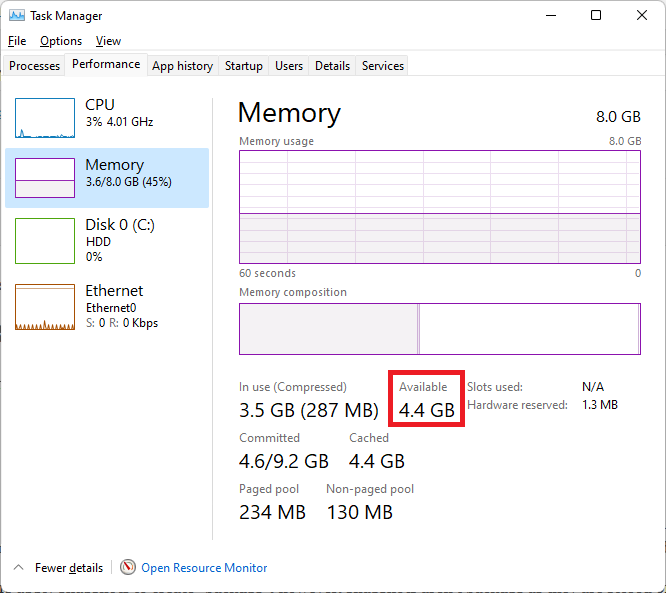General Recommendations
For detailed product information, please visit the BackupChain home page.
This section discusses various recommended practices when working with BackupChain.
Available RAM
Please ensure you have at least 512 MB free or available at all times, as reported by the task manager:

Hyper-V
Microsoft does not recommend using snapshots/checkpoints in production environments. The use of snapshots dramatically reduces performance and also increases complexity. In addition, snapshotted VMs may only restore on similar hardware because they contain processor dependent and other hardware dependent information.
Many Hyper-V users apply snapshots to create “backups”; however, snapshots aren’t backups as they are stored on the same disk as the original. If you want to keep older versions of your virtual machines, simply back them up with BackupChain manually or in scheduled intervals. This is far more efficient and does not involve a run-time performance penalty.
Speed Settings
At least initially most users like the idea of a super-fast backup, the reality is that it puts a strain on your hardware and may impact the server’s responsiveness. For that reason, and especially in a cluster shared volume setting, we recommend limiting the backup to one CPU core, using the lowest task priority, and limiting the read I/O speed of BackupChain to about 15 to 50,000 Kbyte/second as a starting point.
To fine-tune this number, take into account your RAID speed and the average load on the hard drives, relative to their read and write speeds. Also, consider that burst speeds may be multiples of the actual long-term data access speeds. Modern hard drives may burst at over 150MB/sec but only give you a reliable 60MB/sec when reading sequential data.
Defragment your drives as well as your VMs from within often. Defragmentation on the host is recommended if you are using dynamically expanding virtual disks. If you use SSDs there is specialized defragmentation software available that will reduce the wear on the drive’s cells and thereby prolong its life.
For better speed consider using a RAID stripe array with mirror (optionally).
Schedule backups at a time when user access is limited.
Use a gigabit network target, ideally using a dedicated network access adapter just for backup data and with a dedicated connection to the storage devices.
General Recommendations
Reboot your VMs regularly to spot problems early on. A boot error may go undetected and your backup history may not be long enough to restore everything to a bootable state.
Take offline backups at regular intervals in addition to live backups. Shutting down and rebooting will also give you an additional assurance that the VM is in a good state (no boot errors or other disk errors during boot).
Some viruses target the boot sectors of VMs and you may not notice the damage until you reboot. Other common sources of boot problems include: Windows Update, Virus Scanner updates, and other software installations or uninstalls.
Backup Software Overview
The Best Backup Software in 2025 Download BackupChain®BackupChain Backup Software is the all-in-one Windows Server backup solution and includes:
Server Backup
Disk Image Backup
Drive Cloning and Disk Copy
VirtualBox Backup
VMware Backup
FTP Backup
Cloud Backup
File Server Backup
Virtual Machine Backup
Server Backup Solution
Hyper-V Backup
Popular
- Best Practices for Server Backups
- NAS Backup: Buffalo, Drobo, Synology
- How to use BackupChain for Cloud and Remote
- DriveMaker: Map FTP, SFTP, S3 Sites to a Drive Letter (Freeware)
Resources
- BackupChain
- VM Backup
- Knowledge Base
- BackupChain (German)
- German Help Pages
- BackupChain (Greek)
- BackupChain (Spanish)
- BackupChain (French)
- BackupChain (Dutch)
- BackupChain (Italian)
- BackupChain Server Backup Solution
- BackupChain is an all-in-one, reliable backup solution for Windows and Hyper-V that is more affordable than Veeam, Acronis, and Altaro.

